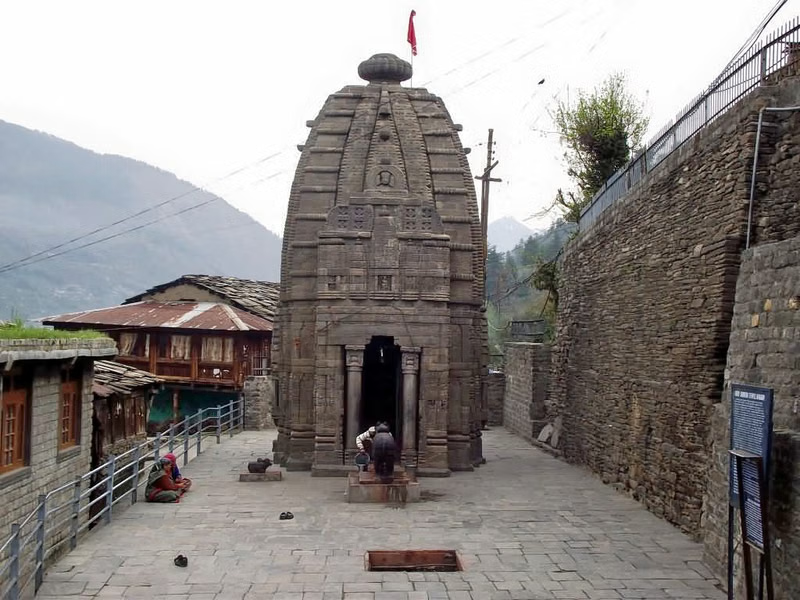Visiting Uttarakhand often feels like walking into a living tapestry of myths, mountains, and rivers. Among the countless temples that dot this sacred landscape, the Gauri Shankar Temple in Dasholi holds a quiet yet powerful charm. While the bigger shrines of Kedarnath, Badrinath, or Jageshwar get most of the spotlight, Gauri Shankar Temple is a place where you feel the Himalayan spirituality in its purest, most intimate form.
I stumbled upon this temple during a trip through Chamoli district, when my driver casually mentioned, “Yahan ek chhota sa mandir hai, lekin bahut pavitra hai” (there’s a small temple here, but it’s very sacred). That line stayed with me. And when I finally set foot in Dasholi and walked towards the stone-carved sanctum, I realized what he meant: small in scale, enormous in energy.
Where Myth and Devotion Meet
The temple is dedicated to Lord Shiva in the form of Gauri Shankar, a name that reflects his eternal union with Goddess Parvati. Locals believe that this shrine has been a place of worship for centuries, built by early devotees who recognized the natural energy of the site.
According to oral traditions, sages meditated here long before the temple structure was raised. The surrounding forests, with their tall deodar and oak trees, were once said to be the abode of rishis. Some villagers even claim that Goddess Parvati herself blessed this land, making it fertile and spiritually potent.
What struck me most was how the temple doesn’t try to overwhelm you with grandeur—it speaks through simplicity. A modest stone structure, intricate carvings, and a naturally peaceful setting combine to create something beyond physical beauty: a sense of timelessness.

First Impressions
As I entered Dasholi village, the road narrowed, winding past terraced fields and small homes. The air smelled of pine and woodsmoke, the kind of fragrance you only get in the Himalayas. The temple itself appeared almost suddenly, standing quietly amidst tall trees, its stone shikhara rising against the backdrop of blue sky and green hills.
Stepping closer, I noticed how the carvings, though weathered, still had fine details—floral motifs, figures of deities, and symbolic patterns that reflect the temple architecture of the region. The temple isn’t massive, but the craftsmanship feels intimate, as if every stone was placed with devotion rather than just engineering.
Inside, the sanctum houses a Shiva Lingam, constantly adorned with flowers, bilva leaves, and offerings from devotees. The fragrance of incense lingered in the air, mixed with the earthy scent of damp stone. I felt a calm heaviness in my chest—the kind of silence where even your thoughts slow down.
The Rituals That Keep It Alive
The daily worship at Gauri Shankar Temple is simple yet deeply moving. Early in the morning, the priest performs abhishekam with water and milk, while villagers come by with small offerings of flowers plucked from their gardens. Unlike big temples where you sometimes feel like a face in the crowd, here every devotee is noticed, every prayer feels personal.
During Maha Shivratri, the temple comes alive with chants, lamps, and all-night vigils. Locals say that people from nearby villages walk barefoot to the shrine, carrying pots of water from streams to pour on the lingam. The aarti during festivals lights up not just the temple but the entire valley, as if the mountains themselves are glowing.
I asked one villager why this temple was so special to them, and his reply stayed with me: “Bade mandir toh sab dekhte hain, par yahan bhagwan sunte hain.” (People see God in big temples, but here, God listens.)
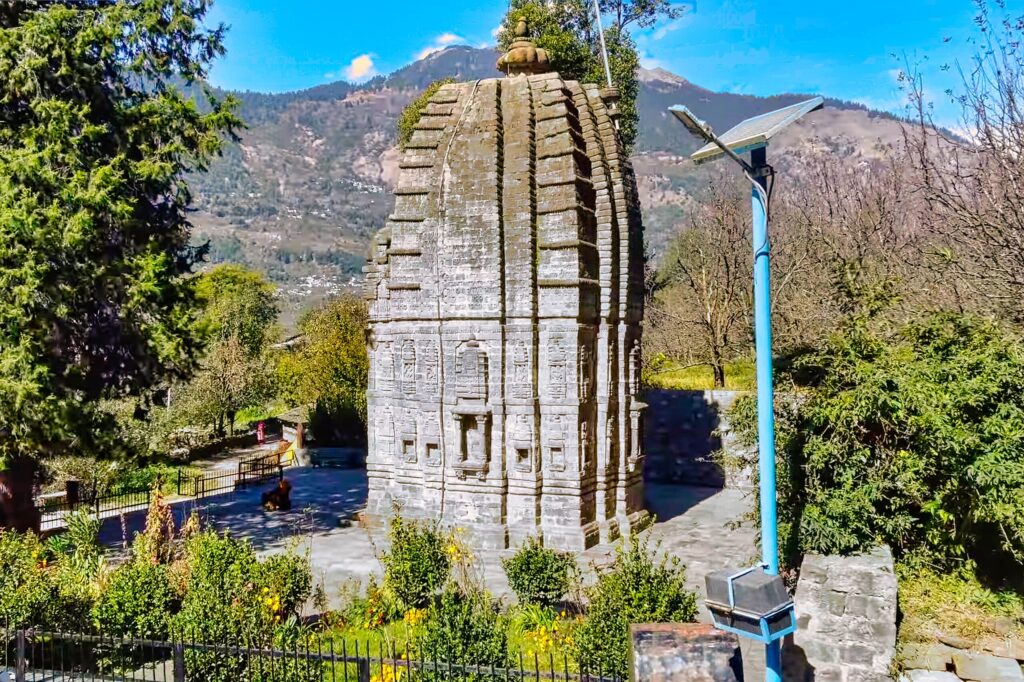
Dasholi – More than Just a Village
What makes the Gauri Shankar Temple even more special is its setting. Dasholi itself is a charming village in Chamoli district, part of the Garhwal Himalayas. Known for its forests and cultural richness, Dasholi is also famous for the Dasholi Gram Swarajya Mandal (DGSM), a cooperative that played a big role in the Chipko Movement of the 1970s.
This movement, where villagers (especially women) hugged trees to prevent deforestation, started in this region and inspired global conversations on environmental conservation. Visiting the temple thus connects you not only to spirituality but also to a legacy of ecological wisdom.
Walking around Dasholi, I noticed how daily life still revolves around nature—farmers working in terraced fields, women carrying baskets of firewood, children running down narrow lanes. It’s a reminder that spirituality here isn’t something separate from life—it’s woven into farming, forests, rivers, and rituals.
The Energy of the Place
If you ask me what makes Gauri Shankar Temple unforgettable, it’s not just the architecture or the legends. It’s the energy.
There’s something about the way the wind moves through the deodar trees, the way the temple bells echo across the valley, the way even stray dogs curl up quietly near the steps. It feels like a space where time pauses, where you can hear not just the sounds around you but also your own heartbeat.
I spent an hour sitting on the temple steps, watching the sky change from pale blue to golden as the sun dipped behind the hills. No rush, no noise, just the slow unfolding of an ordinary yet sacred evening. And in that moment, I understood why locals believe that Shiva truly resides here—not in grand palaces, but in humble, natural, living spaces.
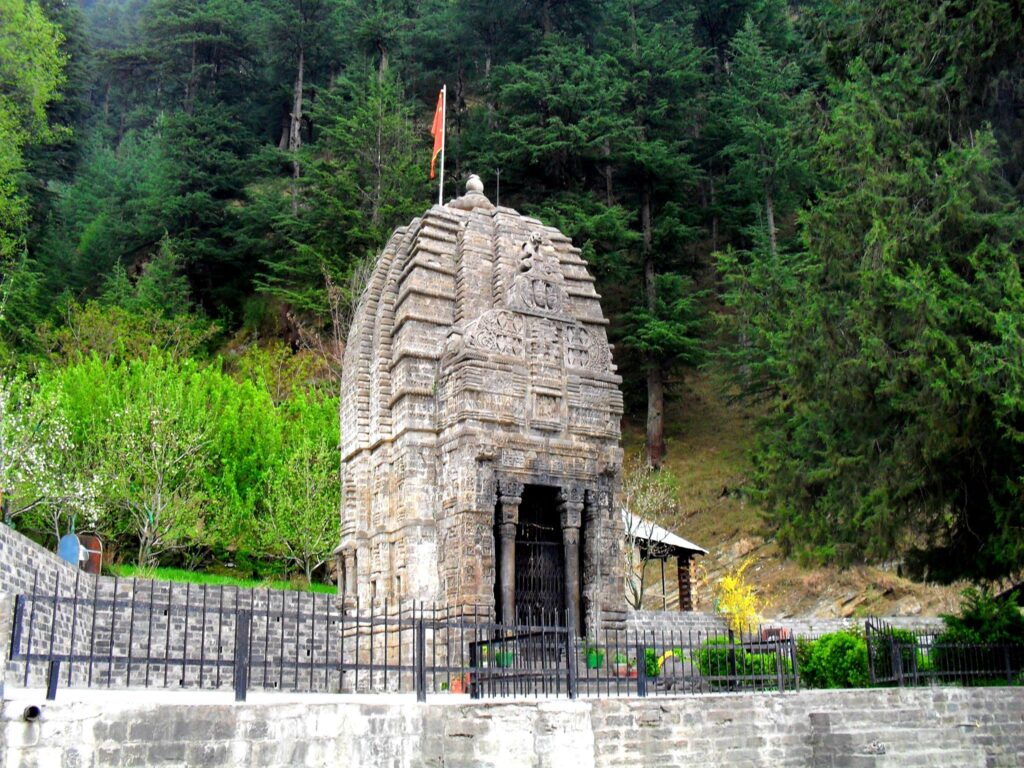
Festivals and Fairs
Like many temples in Uttarakhand, the Gauri Shankar Temple becomes the hub of activity during certain times of the year.
- Maha Shivratri: The most important festival here, with music, chanting, and night-long vigils.
- Shravan Month: Pilgrims especially flock to the temple in the month of Shravan (July–August), carrying water from nearby rivers and streams.
- Village Fairs: At times, the temple courtyard doubles as a gathering place for small fairs, with folk music, dance, and local crafts on display.
What makes these festivals unique is that they are still rooted in community traditions. They’re not commercialized; they’re about faith, food, and togetherness.
Things to Do at Gauri Shankar Temple, Dasholi
When you arrive at the Gauri Shankar Temple in Dasholi, you’ll notice something unique: it isn’t just a place to bow your head and leave. It’s a living space of devotion, history, nature, and local culture. Spending time here means immersing yourself in a blend of spirituality and Himalayan village life. If you give it the patience it deserves, you’ll realize there are many little ways to connect with this temple and its surroundings.
Here are some things to do that will help you experience the temple in its fullest sense.
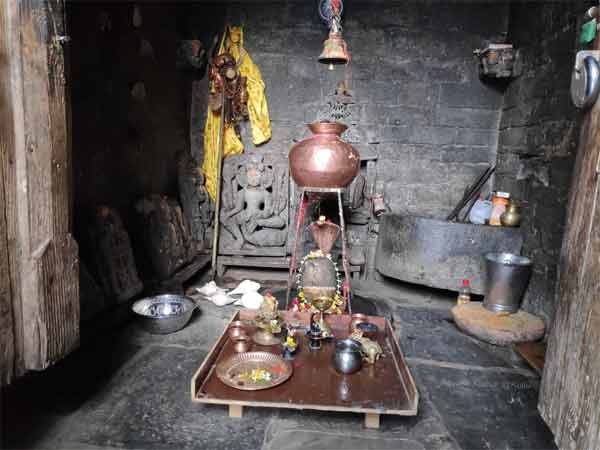
1. Participate in the Morning Abhishekam
Start your day early—really early. At dawn, the temple priest performs the abhishekam of the Shiva Lingam with water, milk, and bilva leaves. The rhythmic chants, the fragrance of incense, and the sound of conch shells create an atmosphere that feels otherworldly.
Standing there, joining your hands as locals softly repeat mantras, gives you a sense of being woven into centuries of devotion. It’s not a performance for visitors; it’s a genuine act of faith you’re invited to share in.
2. Walk Barefoot Around the Courtyard
One of the most grounding things you can do here is to walk barefoot around the stone courtyard. The earth feels cool beneath your feet in the morning and warm by the afternoon sun. Many devotees believe that circling the temple slowly, in meditation, helps cleanse negative energy.
As you walk, notice the carvings on the outer walls—the motifs of flowers, small figurines, and symbols etched by artisans long ago. Each detail tells a story if you’re willing to pause and observe.
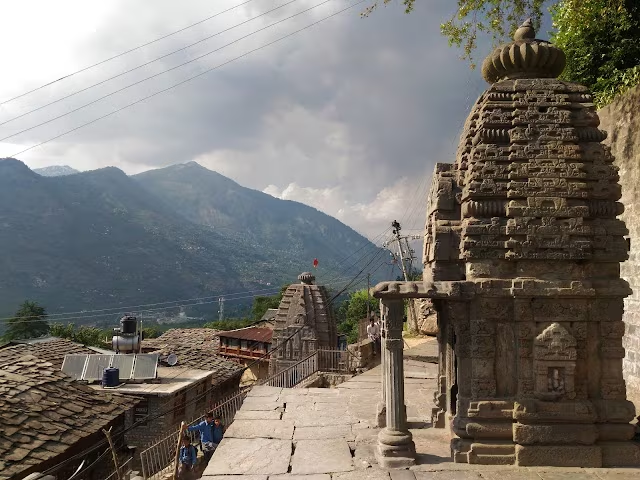
3. Offer Local Flowers and Bilva Leaves
Instead of carrying store-bought offerings, try sourcing flowers and bilva leaves locally. Villagers often grow marigolds and other blossoms in their courtyards, and some families even sell small bundles near the temple entrance. When you place these natural offerings on the Shiva Lingam, it feels more personal—you’ve given something that carries the fragrance of the land itself.
It also supports the local community in a small but meaningful way.
4. Meditate Under the Deodar Trees
The temple is surrounded by tall deodar and oak trees that sway gently with the mountain winds. After offering prayers, find a quiet spot beneath one of these trees. Sit down, close your eyes, and let the natural sounds take over: the rustling leaves, distant bird calls, and the occasional ringing of the temple bell.
Even a short session of meditation here leaves you refreshed. Many believe that the natural setting of Dasholi adds to the temple’s spiritual vibration, making it easier to slip into a peaceful state of mind.
5. Talk to the Priest or Locals
One of the most enriching experiences at Gauri Shankar Temple is conversations. The temple priest often has a treasure trove of stories about the temple’s origins, legends of Lord Shiva, and even personal anecdotes of miracles devotees experienced.
Villagers too will gladly share their perspective. When I visited, a local elder told me how his grandfather used to walk miles barefoot during Shravan month to pour river water on the lingam. These stories aren’t in guidebooks—they’re living traditions you can only absorb through listening.
6. Attend a Festival if You Can
If your timing is right, try to attend during Maha Shivratri or in the month of Shravan (July–August). The temple glows with diyas, the air fills with chants, and the entire community gathers.
Even if you’re just an observer, you’ll feel part of something bigger—an unbroken chain of devotion that stretches back centuries. Watching villagers carry pots of water, women singing folk hymns, and children running with flowers in hand is a memory you’ll carry long after you’ve left.
7. Try Local Food After Darshan
After spending time at the temple, stop at a small eatery or homestay nearby to taste simple Garhwali meals. Hot rotis made from mandua (finger millet), dal from locally grown pulses, and a helping of saag (leafy greens) cooked with mustard seeds—it’s humble, but the kind of food that warms your body after mountain air.
Many homestays in the Dasholi area will happily serve you meals if you ask in advance. Sharing food with locals often opens the door to more conversations and connections.
8. Take a Short Hike Around Dasholi
For those who like walking, the village paths around Dasholi offer gentle hikes through terraced fields and forests. Carry a water bottle, follow the trails that locals use daily, and enjoy the simplicity of village life unfolding around you—farmers working, children playing, women carrying baskets of wood.
Along these paths, you may stumble upon smaller shrines or natural springs. Each one has its own little story, often tied to Shiva or Parvati.
9. Join the Evening Aarti
Don’t miss the evening aarti at the temple. The setting sun paints the sky orange and pink, while bells ring and lamps are lit around the lingam. Unlike the grandeur of big city aartis, this one is small and intimate, but its energy is just as powerful.
The chants rise with the sound of the river in the distance, and as the priest circles the flame, the glow illuminates the old stone walls. Standing among a handful of villagers, you feel less like a visitor and more like part of a family gathering.
10. Spend the Night in a Homestay
If you want the full experience, stay overnight in Dasholi at a village homestay. Waking up to the sound of roosters, sipping chai while watching mist rise from the hills, and walking to the temple before the crowds arrive makes your visit unforgettable.
By night, the stars here are brighter than in the city skies. Sitting under them, you might even hear faint temple bells carried on the wind—a fitting reminder of why you came.
Nearby Attractions
If you’re planning a visit to the Gauri Shankar Temple, make sure to explore some of the gems nearby:
- Joshimath: A spiritual town with connections to Adi Shankaracharya, about 40 km away.
- Auli: The skiing paradise of India, with stunning views of Nanda Devi and surrounding peaks.
- Valley of Flowers National Park: If you’re visiting in summer, this UNESCO World Heritage Site is a must—endless meadows filled with rare Himalayan flowers.
- Badrinath Temple: One of the Char Dham shrines, located further up the Alaknanda valley.
These excursions mean you can combine a peaceful temple visit with adventure, trekking, and more pilgrimage.
Practical Travel Tips
- Best Time to Visit: March to June and September to November. Winters can be very cold and monsoon brings landslides.
- Getting There: Dasholi is accessible by road from Chamoli town. The nearest railway station is Rishikesh, and the nearest airport is Jolly Grant in Dehradun.
- Stay Options: Small guesthouses and homestays in Chamoli and Joshimath offer cozy stays. For a more immersive experience, try staying in a village homestay near Dasholi.
- Local Etiquette: Always remove your shoes before entering the temple, and respect the quiet atmosphere. Offering flowers and bilva leaves is common practice.
FAQs (10)
Q1. Where is Gauri Shankar Temple located?
It stands in Dashal Village, along the Kullu-Manali road, near Naggar in Himachal Pradesh.
Q2. Which deity is worshipped here?
The temple is dedicated to Lord Shiva (Gauri-Shankar), symbolizing the divine couple Shiva and Parvati.
Q3. When was Gauri Shankar Temple built?
It dates back to the 11th–12th century CE and is thought to be the last surviving monument of the Gurjara-Pratihara architectural tradition.
Q4. What makes its architecture unique?
The temple features a towering shikhara with nine tiers, built on a raised platform, richly adorned with carvings of deities, dancers, musicians, and floral motifs.
Q5. Are there notable sculptures inside the temple?
Yes—inside you’ll find idols of Ganesh, Vishnu with Lakshmi, Kartikeya, and an image of Mahishasuramardini, among others.
Q6. What is the temple’s architectural plan?
The sanctum is square and pancharatha in plan, with a triangabada elevation featuring bhadra, pratiratha, and karna projections.
Q7. From where is the temple visible?
The temple faces west and overlooks the beautiful Kullu Valley and Beas River.
Q8. How far is it from major landmarks?
It’s about 5 km from Naggar, 15.5 km from Manali Bus Stand, and roughly 26.5 km from Kullu Bus Stand.
Q9. When is the best time to visit?
The temple is open year-round, but summer (March–June) and winter (October–February) offer the best weather; avoid monsoon due to rainfall risks.
Q10. Is photography allowed and what are the visitor hours?
Photography is typically allowed; the site is open from early morning till evening, though exact hours may vary by season.
Q11. Is Gauri Shankar Temple an ASI-protected monument?
Yes, the temple is maintained by the Archaeological Survey of India due to its historic and architectural importance.
Q12. What is the temple’s connection to Parvati (Gauri)?
The temple is believed to symbolize the divine union of Lord Shiva (Shankar) and Goddess Parvati (Gauri).
Q13. Are there other attractions near the temple?
Yes, nearby attractions include Naggar Castle, Roerich Art Gallery, and temples in Kullu-Manali region.
Q14. What materials were used to build the temple?
The temple is primarily built of stone masonry with intricate carvings, typical of Gurjara-Pratihara style.
Q15. Do locals still worship in the temple?
Yes, despite being a protected monument, the temple remains an active place of worship for villagers and pilgrims.

